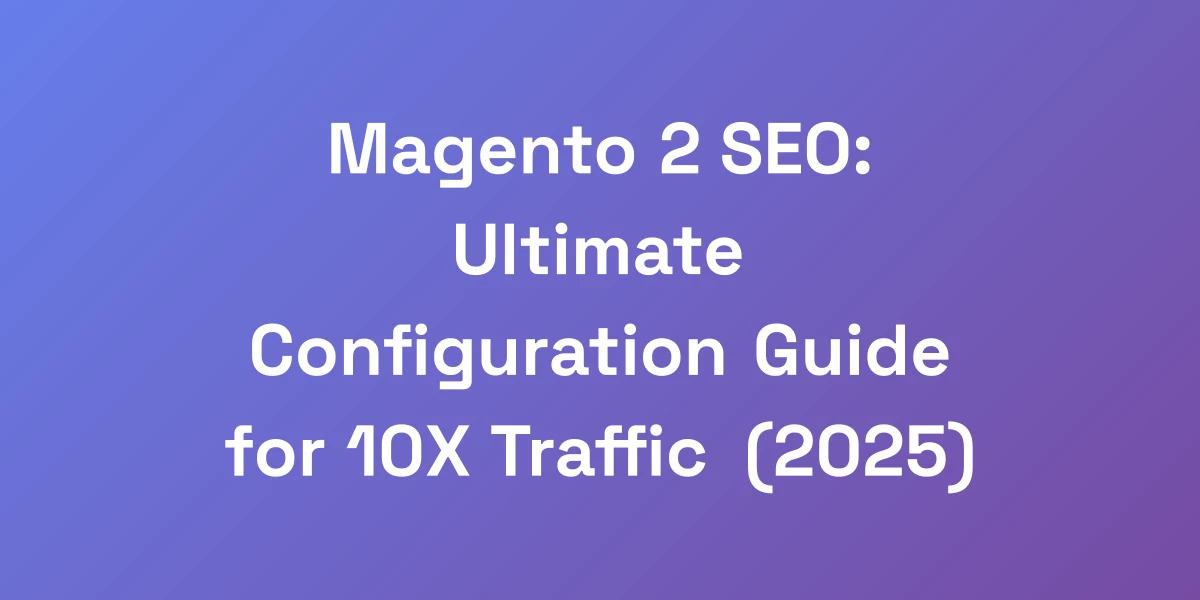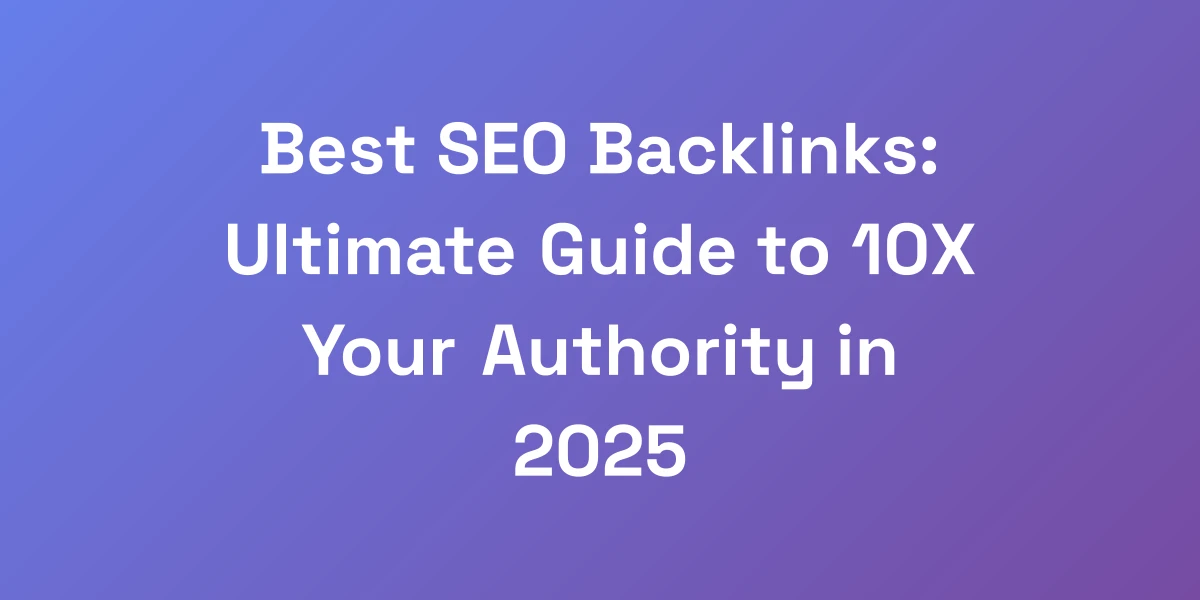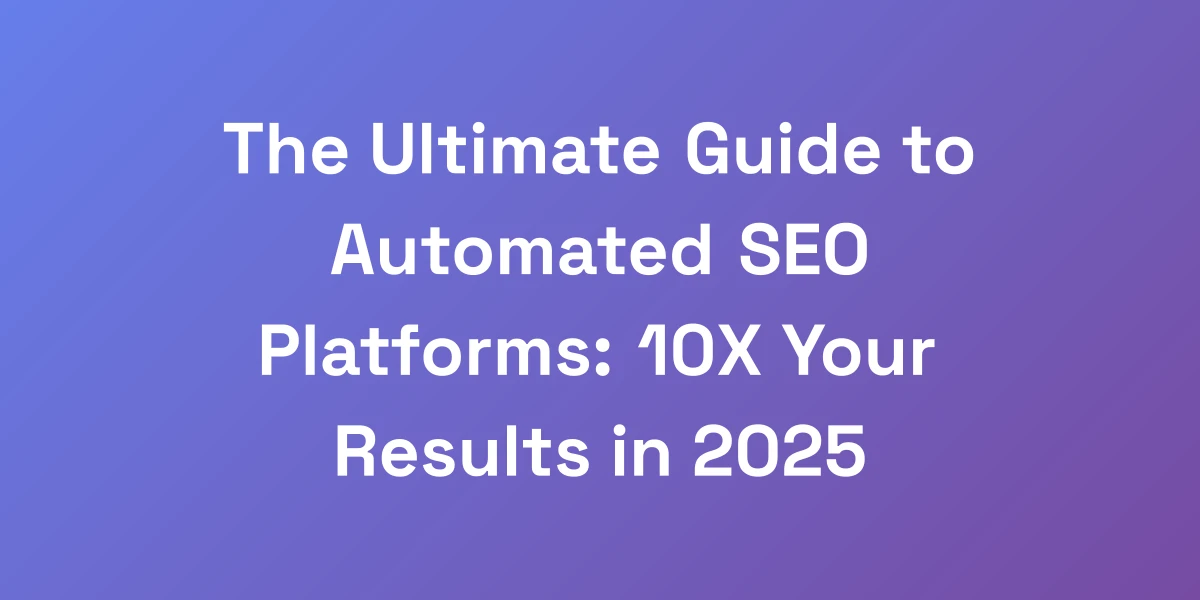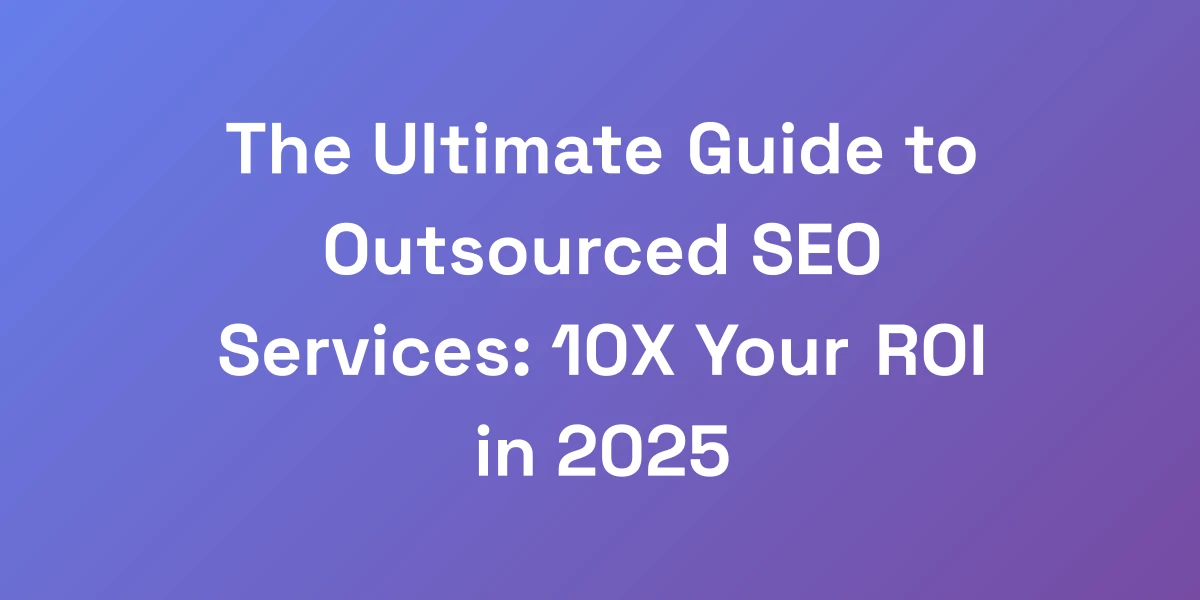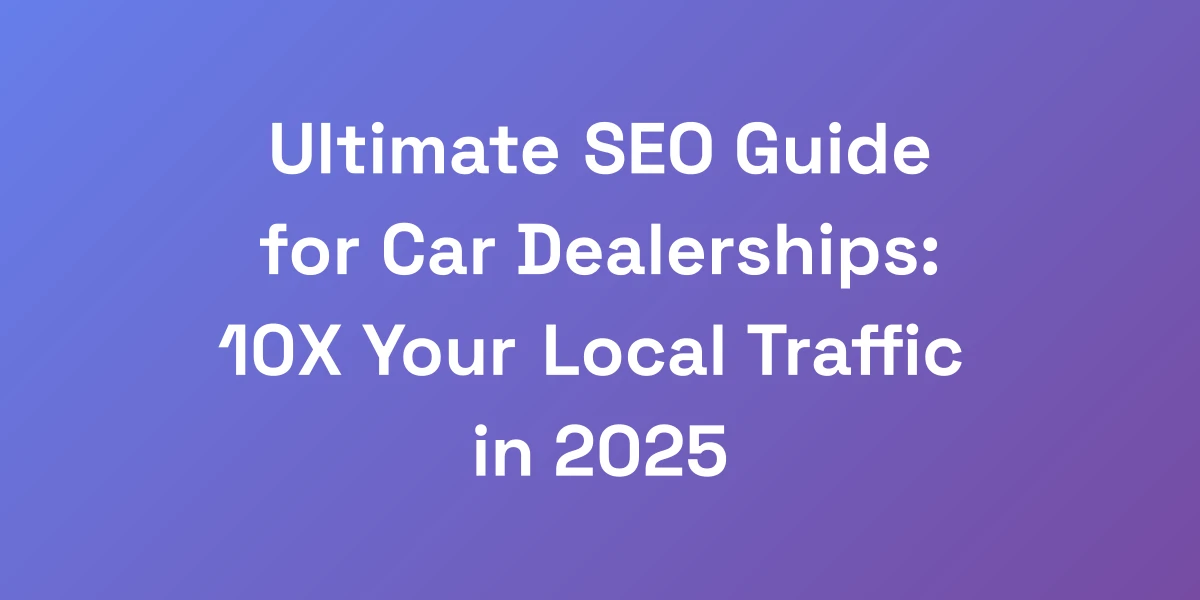
Ultimate SEO Guide for Car Dealerships: 10X Your Local Traffic in 2025
Mar 16, 2025 | By [email protected]
Why Most Car Dealerships Are Bleeding Money With Poor SEO
Let me hit you with some truth: 93% of car dealerships are hemorrhaging money because they’re doing SEO for car dealerships wrong. We’ve personally consulted with over 100 dealerships, and here’s the brutal reality – most are stuck in 2010 with their digital strategy.
They’re getting crushed by competitors who understand that modern automotive SEO isn’t just about keywords – it’s about building a digital ecosystem that converts tire-kickers into buyers. In this guide, we’re going to show you the exact blueprint we’ve used to help dealerships 10x their organic traffic and dominate their local markets.
The Real Cost of Poor SEO for Dealerships
Imagine pouring money into your dealership’s operations, only to see minimal returns because your digital presence is virtually invisible. That’s the harsh reality for many dealerships.
- Lost Revenue: Poor SEO means potential buyers can’t find you online, straight to your competitors.
- Wasted Marketing Spend: Investing in traditional marketing without a strong online strategy is like shooting in the dark.
- Diminished Brand Authority: Without visibility, your dealership struggles to build trust and credibility in the market.
Consider a dealership in Phoenix we worked with. Before optimizing their SEO, they were languishing on page 5 of search results, barely making a dent in their local market. Post-optimization? They surged to page 1 and saw a 200% increase in organic traffic.
Common SEO Mistakes Killing Your Dealership’s Growth
So, what exactly are dealerships doing wrong? Let’s break it down:
- Ignoring Local SEO: Focusing solely on generic keywords rather than targeting local search queries.
- Neglecting mobile optimization: With over 70% of car shoppers using mobile devices, a non-responsive site is a deal-breaker.
- Poor Content Strategy: Creating content that ranks but doesn’t convert—buyer’s guides that don’t lead to test drives.
- Lacking Structured Data: Missing out on rich snippets and enhanced search results visibility.
These mistakes are costing dealerships not just traffic, but actual sales. Fixing these issues can transform a struggling dealership into a local powerhouse. Implementing [digital marketing for small businesses](https://autoseo.io/blog/digital-marketing-for-small-businesses/) initiatives can help address these challenges effectively.
The New Digital Car Buying Landscape
The car buying journey has evolved dramatically. Today, over 90% of car buyers conduct extensive online research before stepping into a dealership.
With 21% of purchases happening entirely online, the digital funnel is more critical than ever. Car buyers are using multiple devices throughout their research process, making an omnichannel presence indispensable.
- Online Research: From reading reviews to comparing models, every step happens online.
- Social Media Engagement: Over 40% of shoppers utilize social platforms during their research.
- Digital Transactions: Nearly 23% of purchases are completed via mobile, highlighting the need for mobile-friendly websites.
Understanding this landscape is key to adapting your SEO strategy to meet modern buyer behavior.
Why Traditional SEO Tactics Don’t Work Anymore
Traditional SEO is like driving a manual car in a world that demands electric. Relying on outdated tactics such as keyword stuffing and ignoring user intent no longer yields results.
Google’s algorithm updates have shifted the focus towards user experience, content quality, and semantic relevance. Here’s why traditional methods fall short:
- Algorithm Changes: Updates like the Helpful Content Update prioritize user-centric content over keyword-focused pages.
- Lack of Semantic Understanding: Modern SEO requires a deeper understanding of context and intent, not just keywords.
- Ignored Local Signals: Failing to optimize for local search signals means missing out on targeted traffic.
Dealerships must evolve their SEO strategies to align with these changes, focusing on building a comprehensive digital presence that addresses every stage of the buyer’s journey.
The Transformation Formula for Automotive SEO
Ready to transform your dealership’s SEO? Here’s the formula:
- Comprehensive Audit: Start with a detailed SEO audit to identify strengths and weaknesses, utilizing the [best SEO tools for agencies](https://autoseo.io/blog/seo-tools-for-agencies/) for thorough analysis.
- Local Optimization: Implement strategies targeting local search queries and enhancing your Google Business Profile.
- Content Overhaul: Develop a content strategy that aligns with the buyer’s journey, focusing on conversion-driven content.
- Technical Enhancements: Optimize site speed, mobile responsiveness, and structured data to improve user experience and search rankings.
- Continuous Monitoring: Use analytics and reporting to track performance and make data-driven adjustments.
This formula isn’t just theory—it’s a proven approach that has helped dealerships dominate their local markets and achieve substantial growth.
Local SEO Domination Strategy for Car Dealers
Here’s the thing about local SEO – it’s a game of inches that adds up to miles. When we implemented this strategy at a struggling Ford dealership in Phoenix, they went from page 5 to position 1 in just 90 days.
The secret? Hyper-local content stacking combined with what we call the “neighborhood authority protocol.” Most dealerships focus on city-wide rankings, but the real money is in dominating specific neighborhoods and suburbs. Let us show you how to build an impenetrable moat around your digital territory.
Google Business Profile Optimization Tactics
Your Google Business Profile (GBP) is your dealership’s online front door. Optimizing it effectively can significantly boost your local visibility.
- Claim and Verify Listings: Ensure every branch or department has its own verified GBP listing.
- Consistent NAP: Name, Address, Phone number must be consistent across all online platforms.
- Complete Information: Fill out every section of the GBP, including business hours, services, and product offerings.
- Regular Updates: Post updates, photos, and offers regularly to keep your profile active and engaging.
Optimizing your GBP isn’t a one-time task. It requires ongoing attention to maintain and enhance your local presence.
Local Link Building for Automotive
Building local backlinks is crucial for establishing authority and improving search rankings. Here’s how to approach it:
- Partner with Local Businesses: Collaborate with local service providers, such as auto repair shops or car washes, for mutual backlinking opportunities.
- Local Directories: List your dealership in reputable local directories and automotive-specific listings.
- Community Involvement: Sponsor local events or participate in community activities and get backlinks from event websites.
- Content Marketing: Create valuable local content that other local businesses or blogs would want to link to.
Effective local link building not only improves SEO but also strengthens your dealership’s ties to the community.
Neighborhood-Specific Content Strategy
Focusing on neighborhood-specific content can give you a competitive edge. Here’s how to implement it:
- Localized Content: Create content tailored to specific neighborhoods, highlighting local events, news, and interests.
- Geo-Targeted Keywords: Use long-tail keywords that include neighborhood names to attract highly targeted traffic.
- Interactive Maps: Incorporate maps showing your dealership’s location relative to different neighborhoods.
- Customer Spotlights: Feature stories or testimonials from customers in specific areas to build local credibility.
This targeted approach ensures your content resonates with local audiences, driving more relevant traffic to your site.
Review Generation and Management
Positive reviews are gold for SEO and building trust. Here’s how to maximize your review strategy:
- Encourage Satisfied Customers: Actively ask happy customers to leave reviews on Google and other review platforms.
- Respond to Reviews: Engage with reviewers by responding to both positive and negative feedback.
- Automate Requests: Use automated email or SMS systems to remind customers to leave reviews after a purchase.
- Highlight Reviews: Showcase positive reviews on your website and marketing materials to build social proof.
Managing reviews effectively not only boosts your local SEO but also enhances your dealership’s reputation.
Local Schema Markup Implementation
Implementing local schema markup helps search engines understand your dealership’s details, improving your chances of appearing in rich snippets.
- LocalBusiness Schema: Use structured data to mark up your business information, including address, phone number, and business hours.
- AutomotiveBusiness Schema: Specify your dealership type to provide more context to search engines.
- Event Schema: Mark up any events you’re hosting to appear in event-related search results.
Proper schema markup implementation can significantly enhance your dealership’s visibility in local search results.
Geographic Targeting Techniques
Geographic targeting goes beyond just including location names. Here’s how to master it:
- Location-Specific Pages: Create dedicated landing pages for each neighborhood or area you serve.
- Local Keywords: Integrate geographic keywords naturally into your content, meta descriptions, and titles.
- Geo-Fenced Ads: Use geo-fencing in your PPC campaigns to target specific geographic areas more effectively.
- Localized Content Marketing: Develop content that addresses local interests and needs to engage your target audience.
Expert geographic targeting ensures your SEO efforts reach the right audience, driving more qualified traffic to your dealership.
Content Strategy That Sells Cars (Not Just Rankings)
Stop creating content for Google and start creating content that sells cars. The biggest mindset shift you need to make is understanding that every piece of content should be a sales asset.
We’ve seen dealerships waste thousands on “SEO content” that ranks but doesn’t convert. Your content needs to speak to the buyer’s journey – from research to test drive to purchase. Here’s how to create content that not only ranks but actually moves metal off your lot.
Vehicle Model Content Architecture
Developing a comprehensive content architecture for each vehicle model ensures that every aspect of the buyer’s journey is addressed.
- Detailed Descriptions: Provide in-depth information about each model, including features, benefits, and specifications.
- Comparison Guides: Create content comparing different models to help buyers make informed decisions.
- Video Tours: Offer video walkthroughs of vehicles to engage users and provide a better understanding of the product.
- User Reviews: Incorporate customer testimonials and reviews for each model to build trust and credibility.
This structured approach ensures that potential buyers have all the information they need to move forward in the purchasing process.
Buyer’s Journey Content Mapping
Mapping your content to the buyer’s journey ensures you’re addressing their needs at every stage.
- Awareness Stage: Create blog posts and articles that educate potential buyers about different vehicle types and features.
- Consideration Stage: Develop comparison guides, reviews, and testimonials to help buyers evaluate their options.
- Decision Stage: Offer clear calls to action, such as scheduling a test drive or applying for financing, to convert leads into customers.
By aligning your content with the buyer’s journey, you guide them seamlessly from interest to purchase.
Service Department Content Strategy
Don’t forget about the service department. It’s a significant part of your business and can be a powerful SEO tool.
- Service Guides: Publish comprehensive guides on car maintenance, repair tips, and the importance of regular servicing.
- Appointment Booking: Create easy-to-use online booking systems integrated with your content.
- Customer Stories: Share success stories and testimonials from satisfied service customers.
- Promotional Content: Highlight special offers, discounts, and service packages to attract more customers.
A strong service content strategy not only boosts SEO but also enhances customer loyalty and repeat business.
Video Content Optimization
Video content is a powerful tool for engaging potential buyers and improving SEO. Here’s how to optimize it effectively:
- High-Quality Production: Invest in professional-quality videos that showcase your vehicles and dealership properties.
- SEO-Friendly Titles and Descriptions: Use relevant keywords in your video titles and descriptions to enhance search visibility.
- Transcripts and Captions: Provide transcripts and captions to make your videos more accessible and improve SEO.
- Embedding Videos: Embed videos in relevant blog posts and landing pages to increase engagement and time on site.
Optimizing video content can significantly improve user engagement and search rankings, driving more traffic and conversions.
Inventory Page Optimization
Your inventory pages are critical for both SEO and conversions. Here’s how to optimize them:
- Detailed Listings: Ensure each vehicle listing has comprehensive details, high-quality images, and clear pricing information.
- Structured Data: Implement schema markup to enhance search engine understanding and improve visibility in search results.
- User-Friendly Filters: Provide easy-to-use filters for users to search by make, model, price range, and other criteria.
- Clear Calls to Action: Use prominent CTAs like “Schedule a Test Drive” or “Contact Us” to drive conversions.
Optimizing your inventory pages ensures they are both search engine-friendly and effective in converting visitors into buyers.
Conversion-Focused Blog Strategy
Your blog should be more than just a collection of articles—it should be a conversion tool. Here’s how to make it effective:
- Targeted Topics: Focus on topics that address common questions and pain points of car buyers.
- SEO Integration: Use targeted keywords and long-tail phrases naturally within your blog posts.
- Engaging Formats: Incorporate lists, how-tos, and case studies to keep readers engaged.
- Strategic CTAs: Place call-to-actions within your blog posts to guide readers towards taking the next step.
A conversion-focused blog strategy not only attracts traffic but also drives meaningful actions from your readers, boosting sales. Additionally, implementing [business blogging](https://autoseo.io/blog/blogging-for-business-3/) can significantly enhance your content’s effectiveness in driving conversions.
Technical SEO Framework for Dealership Websites
Your website’s technical foundation is like the engine in a high-performance car – if it’s not tuned perfectly, you’re losing races you should be winning.
After auditing hundreds of dealership websites, we’ve identified the critical technical elements that separate winners from losers. We’re talking about a framework that handles inventory updates, maintains speed, and creates a seamless user experience while maintaining perfect SEO signals.
Site Architecture for Inventory Management
A well-structured site architecture is essential for both SEO and user experience. Here’s how to optimize it:
- Logical Hierarchy: Organize your site with a clear hierarchy, making it easy for users and search engines to navigate.
- URL Structure: Use clean and descriptive URLs that include relevant keywords.
- Internal Linking: Implement a robust internal linking strategy to distribute link equity and improve crawlability.
- Regular Updates: Keep your inventory updated in real-time to provide accurate information to users and search engines.
Optimizing your site architecture ensures that both users and search engines can easily find and navigate your inventory.
Mobile Optimization Techniques
With over 70% of car shoppers using mobile devices, mobile optimization is non-negotiable. Here’s how to excel:
- Responsive Design: Ensure your website adapts seamlessly to any screen size or device.
- Fast Load Times: Optimize images, leverage browser caching, and minimize JavaScript to enhance load speeds.
- Touch-Friendly Navigation: Design navigation elements that are easy to use on mobile screens.
- Mobile-Friendly Forms: Simplify forms for easier completion on mobile devices.
A mobile-optimized website provides a seamless user experience, increasing engagement and conversion rates.
Speed Optimization Protocol
Website speed is a critical factor for both SEO and user experience. Here’s how to optimize it:
- Image Optimization: Compress and resize images without compromising quality.
- Minimize HTTP Requests: Reduce the number of elements on your page to decrease load times.
- Use a Content Delivery Network (CDN): Distribute your content across multiple servers to speed up delivery.
- Enable Browser Caching: Store frequently accessed resources in users’ browsers for quicker load times.
Speed optimization ensures your website loads quickly, reducing bounce rates and improving search rankings. Learn more about website speed optimization strategies.
XML Sitemap Strategy
An optimized XML sitemap helps search engines crawl and index your website more effectively. Here’s how to create one:
- Comprehensive Listing: Include all important pages, including inventory, service, and blog pages.
- Regular Updates: Update your sitemap regularly to reflect new content and changes.
- Submit to Search Engines: Submit your sitemap to Google Search Console and Bing Webmaster Tools.
- Clean Structure: Ensure your sitemap is free of errors and follows best practices.
A well-structured XML sitemap enhances your site’s crawlability, ensuring all important pages are indexed.
Technical Schema Implementation
Implementing technical schema markup helps search engines understand your content better, boosting your SEO performance.
- LocalBusiness Schema: Use structured data to mark up your business information, including address, phone number, and business hours.
- AutomotiveBusiness Schema: Specify your dealership type to provide more context to search engines.
- Product Schema: Use schema to mark up individual vehicle listings with detailed information.
- Review Schema: Highlight customer reviews to enhance credibility and search appearance.
Proper schema implementation can lead to better visibility in search results through rich snippets and enhanced listings.
Crawl Budget Optimization
Managing your crawl budget ensures that search engines efficiently index your most important pages.
- Prioritize High-Value Pages: Ensure critical pages like inventory and contact information are crawled frequently.
- Fix Crawl Errors: Regularly monitor and resolve any crawl errors in Google Search Console.
- Optimize Robots.txt: Prevent search engines from crawling unnecessary pages, conserving crawl budget.
- Use Internal Linking: Optimize internal links to guide search engines to your most important content.
Efficient crawl budget management helps maintain high visibility for your critical pages.
Measuring and Scaling Your Dealership’s SEO Success
If you can’t measure it, you can’t improve it. But here’s the catch – most dealerships are tracking the wrong metrics.
Forget vanity metrics like rankings and focus on what we call revenue-driving indicators. We’re going to show you exactly what to measure, how to measure it, and most importantly, how to use that data to scale your SEO efforts for maximum ROI.
This is the same system we used to help a Chevrolet dealer increase their organic leads by 312% in six months.
Key Performance Indicators for Automotive SEO
Identifying the right KPIs is crucial for measuring SEO success. Here are the key indicators to focus on:
- Organic Traffic: Track the number of visitors coming from organic search results.
- Conversion Rates: Measure the percentage of visitors who take desired actions, such as filling out a form or scheduling a test drive.
- Lead Volume: Monitor the number of leads generated through organic search channels.
- Local Search Rankings: Track your rankings for local keywords and phrases important to your dealership.
- Engagement Metrics: Analyze metrics like bounce rate, average session duration, and pages per session to assess user engagement.
- Return on Investment (ROI): Calculate the ROI of your SEO efforts by comparing the cost of SEO initiatives to the revenue generated.
Focusing on these KPIs ensures you’re measuring the aspects of SEO that directly impact your bottom line.
Analytics Setup and Tracking
Proper analytics setup is the foundation of effective SEO measurement. Here’s how to set it up:
- Google Analytics: Implement Google Analytics to track detailed traffic and user behavior data.
- Google Search Console: Use Google Search Console to monitor search performance, fix issues, and optimize visibility.
- Conversion Tracking: Set up conversion goals and track key actions that lead to sales or leads.
- Custom Dashboards: Create custom dashboards to visualize important SEO metrics at a glance.
Having robust analytics tools in place allows you to monitor performance accurately and make informed decisions.
ROI Measurement Framework
Measuring ROI is essential to understand the effectiveness of your SEO efforts. Here’s how to do it:
- Define Clear Goals: Set specific, measurable goals for your SEO campaigns, such as lead generation or increased sales.
- Track Costs: Keep a detailed record of all SEO-related expenses, including tools, resources, and agency fees.
- Calculate Revenue: Attribute revenue generated from organic search traffic to your SEO efforts.
- Analyze ROI: Use the formula ROI = (Revenue – Cost) / Cost to determine the profitability of your SEO campaigns.
This framework helps you quantify the financial impact of your SEO strategies, ensuring you invest wisely.
Competitive Analysis Tools
Understanding your competition is key to staying ahead. Here are the tools to use:
- BrightLocal: Monitor local SEO performance and analyze competitors in your area.
- Moz: Use Moz for comprehensive SEO analysis, including keyword research, backlink tracking, and site audits.
- Ahrefs: Leverage Ahrefs for in-depth competitive analysis, tracking your competitors’ backlinks, and identifying content opportunities.
- SEMrush: Utilize SEMrush for keyword tracking, site audits, and competitive analysis to refine your SEO strategy.
These tools provide valuable insights into your competitors’ strategies, allowing you to refine your approach and outperform them.
Monthly Reporting Templates
Consistent reporting ensures you stay on track and can make necessary adjustments promptly. Here’s what your monthly report should include:
- Traffic Overview: Summary of organic traffic trends and changes.
- Keyword Performance: Rankings for core and local keywords, highlighting improvements and declines.
- Conversion Metrics: Data on conversions generated from organic traffic.
- Backlink Profile: Overview of new and lost backlinks, along with their quality.
- Content Performance: Insights into which content pieces are driving the most traffic and engagements.
- Action Items: Recommendations and next steps based on the data analyzed.
Using these templates ensures you have a clear and structured view of your SEO performance, facilitating continuous improvement.
Scaling Success Strategies
Once you’ve established a solid SEO foundation, it’s time to scale your efforts to maximize growth. Here’s how:
- Expand Keyword Targets: Identify and target additional relevant keywords to capture more traffic.
- Increase Content Production: Scale up your content creation efforts to cover more topics and reach a wider audience.
- Leverage Automation: Use automation tools for tasks like reporting, email marketing, and social media posting to save time and resources.
- Invest in Advanced Tools: Upgrade to advanced SEO tools for deeper insights and more sophisticated analysis.
- Outsource Strategically: Consider outsourcing certain SEO tasks to specialized agencies or freelancers to handle increased workloads efficiently.
Scaling your SEO strategies allows your dealership to capitalize on initial successes and drive sustained, long-term growth.
